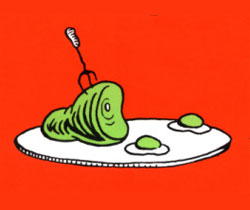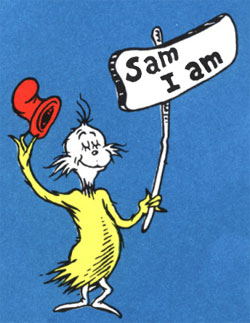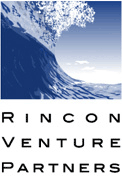 Many voluminous books have been written about sales, some technical, some strategic and some tactical. However, there really is only one book that you need to read on the subject of sales and that book comes from a very unlikely source, Dr. Seuss.
Many voluminous books have been written about sales, some technical, some strategic and some tactical. However, there really is only one book that you need to read on the subject of sales and that book comes from a very unlikely source, Dr. Seuss.
Without realizing it, Dr. Seuss drafted the salesman’s manifesto in the form of “Green Eggs and Ham”. If you have an average salesperson’s intellect, like myself, you will find the book especially appealing, as it only utilizes 50-distinct words, 48-of which are only one syllable.
The Plot
 Our protagonist, Sam, is an androgynous creature, which fits well with his / her asexual name. This depiction makes Sam’s appeal universal. Man or woman, the tactics deployed by Sam are applicable to any sales situation and can be put to use by any salesperson, irrespective of their gender. For sake of grammatical convenience, I will refer to Sam as a man in the remainder of this entry.
Our protagonist, Sam, is an androgynous creature, which fits well with his / her asexual name. This depiction makes Sam’s appeal universal. Man or woman, the tactics deployed by Sam are applicable to any sales situation and can be put to use by any salesperson, irrespective of their gender. For sake of grammatical convenience, I will refer to Sam as a man in the remainder of this entry.
The story begins with the unwitting, future customer relaxing and reading the paper. Sam-I-Am enters stage right, riding a Seussian creature and holding a sign which reads, “Sam-I-Am”.
This is Sam’s cold call. The last thing on the Prospect’s mind is buying something from Sam or anyone else for that matter. However, Sam is fearless. He introduces himself to his Prospect wearing a large, sincere smile.
Why is Sam smiling? Is it because he is trying to ‘trick’ the customer? Is he already counting his future commission? Is his smile a cynical attempt to disarm the Prospect and ingratiate himself?
No, the answer is D: None of the above.
Sam is smiling because he knows that he has something the Prospect will love and eventually thank him for bringing to his attention. He is so confident in his green eggs and ham ‘product’, that he cannot do anything but smile.
The customer’s initial reaction is rather predictable. He is irritated at being interrupted by an unsolicited salesperson, just like you would be if you received a telemarketing call during dinner. Thus, without knowing who Sam is or what he is selling, the Prospect lashes out and tells Sam that he, “does not like him”. Right from the start, Sam is forced to endure the most painful of all forms of rejection, a personal attack.
However, Sam remains undeterred. He continues smiling and deploys a rudimentary sales technique. Instead of acknowledging the personal repudiation, he poses a simple question in a form which cannot be answered with “no”. He asks the Prospect if he would like the product “here or there”, pointing to two spots on the ground and smiling his winning smile.
As the book continues, the studious reader will note Sam’s subtle but powerful use of body language. When reprimanded by the Prospect, he is appropriately conciliatory, looking up at the Prospect with puppy dog eyes and a sorrowful look of disappointment. However, when posing a question, he turns on his smile and raises his eyebrows, forcing the Prospect to fill the silence with a reply.
Despite being a children’s book, it makes for painful reading, as Sam is repeatedly rejected, at times in a vicious manner. However (Spoiler Warning…) Sam’s persistence finally wears the Prospect down, at which point he makes a deal with Sam.
In exchange for demoing the product, he asks that Sam to agree to leave him alone after the demo. Sam smiles but never explicitly acknowledges this ‘deal’, thereby giving himself the option of continuing his sales tactics, irrespective of the Prospect’s reaction to the demo.
Fortunately, Sam does not have to continue ‘selling’ once the demo is completed. After trying the product, the Prospect grins broadly, puts his arm around Sam and tells him, “Thank you. Thank you. Sam-I-Am.”
Sam-I-Am Lessons Learned
There are a number of practical sales lessons that we can draw from this opus, including the following:
- Persistence - As every sales textbooks will tell you, there is no substitute for persistence. Sam exemplifies this truism. Until the moment the Prospect finally demos the product, it appears that Sam has no chance of success. However, Sam never loses hope, and never gives up.
- Research – Sam’s persistence is not born of ignorance. His knowing smile indicates that he is highly confident that his product is ‘right’ for the Prospect and that it is his ‘duty’ to ensure that the Prospect experiences the product’s value first-hand. This perspective is crucial to a salesperson’s ultimate success. You must have enough confidence in your product to push through baseless objections and ensure that your Prospect experiences your product, and thereby judges it on its merits. An effective way to bolster your confidence is to research and fully understand the degree of fit between your product and the Prospect’s needs. The reason Sam can handle the litany of rejections is because he is confident that his product is a good fit for the Prospect, due to his thorough research.
- No Drama – Sam also realizes that the Prospect’s reaction is not based on knowledge – his blanket rejection is a coping mechanism that many people utilize to deal with the competing demands on their time. Sam does not get caught up in the Prospect’s emotions. Instead, he remains focused on encouraging the Prospect to demo his product, as Sam knows that the product will deliver real value to the Prospect and that the Prospect will ultimately “thank him” for introducing him to the product, once he validates the value proposition firsthand.
- Affability – Sam remains affable throughout the entire sales process. Even when the prospect personally attacks him, and is downright rude, Sam realizes that the ultimate payoff (his commission and the Prospect’s satisfaction with the product) make dealing with the short-term discomforts bearable.
- Listen and Adapt – Sam listens to his Prospect’s objections and adjusts his tactics to best suit an evolving situation. He probes to better understand his Prospect’s needs with questions like, “would like the product, in a box, with a fox, on a train, in the rain, with a mouse, etc”. In each instance, Sam actively listens to his Prospect’s responses, and attempts to satisfy all of his needs by creating third-party bundles that offer his Prospect holistic solutions. Effective salespeople attempt to satisfy all their prospects’ needs, even those needs which extend beyond what his product can fulfill on its own. Such value-added selling elevates the salesperson’s role to that of a consultive partner.
- Manage Expectations – Sam does not tout his product’s features, nor does he oversell his product. Instead, he focuses on the objective at hand, which is to get his Prospect to demo the product. By avoiding puffery and overselling, Sam is able to reach his goal of performing a demo while still setting low expectations. By properly managing the Prospect’s expectations, Sam has lowered the bar with respect to the impact his product must make to grab the Prospect’s attention. This ‘expectation management’ significantly contributes to the Prospect’s eventual positive user experience. By the time the Prospect finally tries the product, he fully expects to be disappointed. Thus, he is delighted when he realizes that the product delivers value to him, despite his misgivings.
- Humility – Sam remains humble and committed to his Prospect’s satisfaction throughout the sales cycle, even after the Prospect becomes a Customer and admits that he loves the product.Once the sale is completed, it would be tempting for Sam to say, “I told you so”. However, he realizes that he is forming a long-term relationship with his Customer, which must be based on mutual respect. Any insinuation of “I told you so” could engender animosity that would undercut the good rapport that Sam has worked so hard to establish.
Throw out Porter, Moore and Christensen and make room for Dr. Seuss. After all, “Green Eggs and Ham” helped the US win the Cold War - it might prove to be an equally effective ‘secret weapon’ for you as well.
Your Turn
This list only scratches the surface of the lessons that can be drawn from “Green Eggs and Ham”. What other “Lessons” that can be drawn from this master work? I look forward to reading your thoughts.




Pingback: Monopoly at RevUpNet
Pingback: Making Stone Soup at RevUpNet
Pingback: Quora
Pingback: Pawn Stars Teaches Entrepreneurs How To Not Negotiate